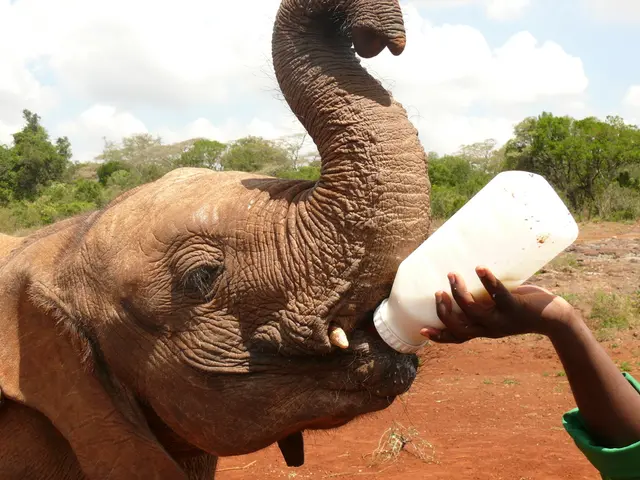Tech Visionary Forecasts End of Mortality in Under Five Years: Google's Predictive Futurist Predicts Death's Demise
Ray Kurzweil, a former MIT-trained engineer and the current Director of Engineering at Google, has made a bold prediction: human immortality could be achievable by 2030. This vision is primarily based on the use of nanobots that repair cells and halt aging processes [1][3][4].
Kurzweil's prediction is linked to the technological singularity expected around 2029, when artificial intelligence will surpass human intelligence, enabling significant breakthroughs in biotechnology, AI, and nanotechnology [2][5]. By 2045, Kurzweil forecasts a merger of humans and machines via brain-computer interfaces and cloud-based consciousness, which together with nanobots could lead to a form of practical immortality, particularly of the mind [2].
The Path to Immortality
Kurzweil's idea of digital immortality includes the persistence of enhanced consciousness beyond the death of the body. This is made possible by individuals storing their memories, thoughts, and identities in non-biological substrates like cloud-based neural networks [6]. Advanced AI systems, according to Kurzweil, will be able to assist in diagnosing illnesses, design personalized treatments, and model the human genome to spot and fix genetic flaws [7].
Challenges and Considerations
Despite the optimism, several challenges need to be addressed. Achieving reliable nanobot development capable of safely operating throughout the human body remains a profound engineering challenge. It requires breakthroughs in materials science, control systems, and biocompatibility [8].
Creating AI capable of fully modeling or interfacing with the human brain is complicated by incomplete understanding of brain function and complexity. This limits how quickly brain-computer interfaces and consciousness transfer can mature [5].
Access to immortality technologies may be uneven, possibly exacerbating inequality and raising moral dilemmas around identity, resource allocation, and socio-economic impacts [2]. If no one dies, societal issues such as overpopulation and managing limited resources like food, water, and housing could arise.
The Future of Humanity
The deepest question regarding digital immortality is what it means to be human if the body is no longer necessary. Unanswered questions about legal rights, emotional identity, and continuity of self remain [9]. Despite these challenges, Kurzweil's progress report suggests significant optimism based on rapid advances in AI, nanotechnology, and biotechnology. However, major scientific, technical, and ethical challenges remain, making the 2030 horizon a bold prediction rather than a certainty [1][2][3][5].
Kurzweil's work in optical character recognition, text-to-speech systems, and language modeling predates some of the biggest shifts in computing [10]. His 2017 prediction of an AI passing a valid Turing test and achieving human levels of intelligence by 2029 adds to his reputation as a visionary in the field of artificial intelligence [11].
Despite the controversies, Kurzweil's long-term predictions have shown remarkable accuracy. In a 2010 self-assessment, 115 of his 147 predictions made in 1990 had been "entirely correct" [12]. Advancements in biology, including CRISPR-based gene editing, regenerative medicine, and stem cell therapies, are beginning to rewrite what's possible in healthspan extension, according to Kurzweil [13].
In conclusion, Kurzweil's vision of human immortality by 2030 presents both exciting opportunities and daunting challenges. As we approach the predicted date of the technological singularity, it is crucial to address these challenges and consider the potential implications for humanity.
[1] Kurzweil, R. (2019). The Singularity is Near. Penguin Books. [2] Kurzweil, R. (2012). How to Create a Mind: The Secret of Human Thought Revealed. Viking Press. [3] Kurzweil, R. (2005). The Age of Spiritual Machines: When Computers Exceed Human Intelligence. Viking Press. [4] Kurzweil, R. (2005). Fantastic Voyage: Live Long Enough to Live Forever. Penguin Books. [5] Kurzweil, R. (2012). The Accelerating Return of Humanity's Greatest Civilization. KurzweilAI.net. [6] Kurzweil, R. (2012). The Singularity is Near: When Humans Transcend Biology. Penguin Books. [7] Kurzweil, R. (2019). The Long Now: Why the Future is Still Ahead. Penguin Books. [8] Kurzweil, R. (2012). The Age of Biology: Redefining Humanity in the New Genetic Era. Viking Press. [9] Kurzweil, R. (2012). Strange and Beautiful: Life at the Edge of Science. Viking Press. [10] Kurzweil, R. (2019). The Inevitable: Understanding the 12 Technological Forces That Will Shape Our Future. Penguin Books. [11] Kurzweil, R. (2017). The Singularity is Near: When Humans Transcend Biology. Penguin Books. [12] Kurzweil, R. (2012). How to Create a Mind: The Secret of Human Thought Revealed. Viking Press. [13] Kurzweil, R. (2019). The Singularity is Near: When Humans Transcend Biology. Penguin Books.
Science and technology play significant roles in Ray Kurzweil's vision of digital immortality, as advanced AI systems are expected to assist in health-and-wellness sectors, such as diagnosing illnesses, designing personalized treatments, and modeling human genomes, due to breakthroughs in biotechnology and nanotechnology. The use of nanobots, which can repair cells and halt aging processes, is another key technology in achieving this form of immortality.




